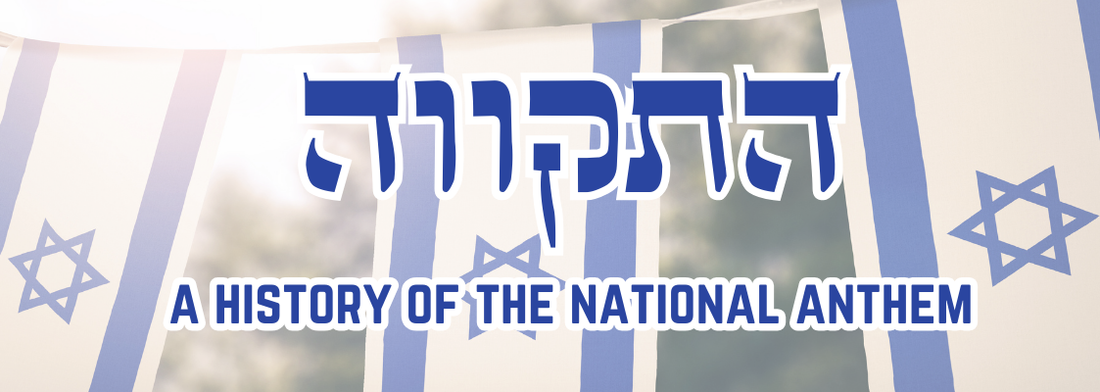
The History of Hatikvah: Israel’s National Anthem
Share
Hatikvah (“The Hope”) isn’t just a national anthem—it’s a window into the soul of the Jewish people. Its words and melody carry the weight of centuries of yearning, the resilience of a people in exile, and the triumph of returning to a homeland. But how did this song, born from a wandering poet’s pen, become the anthem of Israel? Here’s the story.
Naphtali Herz Imber, the poet behind Hatikvah, was born in 1856 in Galicia, a region that today lies between Poland and Ukraine. Home to a rich Jewish culture, Galicia was also a place of hardship, where antisemitism and poverty ran deep. Against this backdrop, Imber wrote a nine-stanza poem called Tikvatenu (“Our Hope”) in 1877. It expressed the collective longing of the Jewish people for their ancestral homeland, a yearning deeply embedded in Jewish prayers and traditions.
The most famous lines of his poem, now the lyrics of Hatikvah, focus on the enduring hope of the Jewish people over 2,000 years. Imber’s words quickly gained traction, carried by his charismatic personality as he traveled through Europe and Ottoman Palestine.
The melody that gives life to Hatikvah came later. In 1888, Samuel Cohen, a Moldavian immigrant, adapted a folk tune called La Mantovana. This melody, known across Europe in various forms, carried both a melancholy and a yearning that perfectly complemented Imber’s words. The result was a song that felt timeless, capturing both the sorrow of exile and the hope for redemption.
When the State of Israel was declared in 1948, Hatikvah was already widely sung and deeply loved. It was performed at the declaration of independence, cementing its place in the national psyche. However, despite its popularity, it wasn’t formally adopted as the national anthem until 2004. Under the leadership of Prime Minister Ariel Sharon, the Knesset passed the National Symbols Law, officially designating Hatikvah as the anthem of Israel and solidifying its role in the country’s identity.
Alternatives to HaTikvah That Were Considered as Israel's National Anthem
While Hatikvah eventually emerged as the anthem of Israel, the road to its adoption wasn’t without alternatives. In the formative years of the state, several other songs were proposed, each reflecting a different facet of Israel’s identity, priorities, and vision.
One notable contender was “Yerushalayim Shel Zahav” (“Jerusalem of Gold”), written by Naomi Shemer in 1967. This song gained immense popularity after the Six-Day War, becoming a de facto anthem of sorts during the euphoric period following the reunification of Jerusalem. Its poignant lyrics and sweeping melody evoked the spiritual and historical connection to Jerusalem, Israel’s eternal capital. However, it emerged too late in the timeline to rival Hatikvah, and its focus on Jerusalem, while powerful, lacked the broader national aspirations encapsulated in Hatikvah.
Another option was “HaTikvah Hachadasha” (“The New Hope”), a variation of Hatikvah’s original lyrics. This adaptation sought to modernize the anthem’s language, making it more inclusive and relevant to the realities of the young state. However, it failed to gain traction, as many felt it diluted the raw emotion and historical depth of the original Hatikvah.
Several proposals came from religious leaders and communities who advocated for a more explicitly spiritual anthem. These included hymns such as:
- “Shir HaMa’alot” (Psalm 126): This psalm, recited in Jewish liturgy and associated with the return to Zion, begins with the words, “When the Lord returned the exiles of Zion, we were like dreamers.” Its themes of divine intervention and redemption made it a fitting choice. However, critics argued that its exclusively religious tone might alienate Israel’s secular majority and fail to reflect the broad, inclusive vision of the Zionist movement.
- “Hodu L’Adonai Ki Tov” (Give Thanks to the Lord for He is Good): Taken from Psalm 136, this hymn’s refrain, “For His mercy endures forever,” celebrates the enduring faith and gratitude of the Jewish people. Like Shir HaMa’alot, it was seen as too narrowly focused on religious sentiments.
- “Adon Olam” (Master of the Universe): This hymn, familiar from synagogue services, is a timeless declaration of faith. Its universal themes of trust in God and divine sovereignty appealed to many, but it lacked the nationalistic tone necessary for a state anthem.
Each of these alternatives had its champions, but none could match the emotional resonance and unifying power of Hatikvah. The Zionist movement, while steeped in Jewish tradition, was predominantly secular and sought to create a national identity that bridged religious and non-religious communities. Hatikvah’s focus on hope, freedom, and self-determination made it a natural choice, embodying both the spiritual and secular aspirations of the Jewish people.
The Full Lyrics to HaTkivah
Hebrew:
כל עוד בלבב פנימה
נפש יהודי הומיה,
ולפאתי מזרח קדימה
עין לציון צופיה.
עוד לא אבדה תקוותנו,
התקווה בת שנות אלפיים,
להיות עם חופשי בארצנו,
ארץ ציון וירושלים.
HaTikvah Transliteration:
Kol od balevav penimah
Nefesh Yehudi homiyah,
Ulfatei mizrach kadimah
Ayin letziyon tzofiyah.
Od lo avdah tikvatenu,
Hatikvah bat shnot alpayim,
Lihyot am chofshi be’artzenu,
Eretz Tzion v’Yerushalayim.
HaTikvah English Translation:
As long as in the heart within
The soul of a Jew still yearns,
And toward the East, an eye looks to Zion,
Our hope is not yet lost.
It is two thousand years old,
To be a free nation in our land,
The land of Zion and Jerusalem.
Carry the Hope of HaTikvah with You
Hatikvah isn’t just a song; it’s the story of a people who refused to give up on their dreams. It’s a reminder of what can be achieved when hope is kept alive. Celebrate this spirit and carry the hope with you by exploring our Hatikvah-inspired t-shirts and products.












